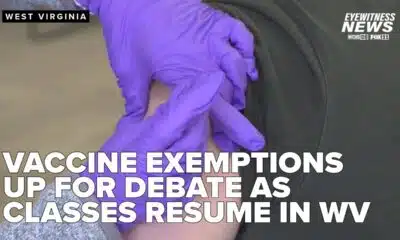News from the South - West Virginia News Feed
In a state plagued by poor health outcomes, one WV educator is transforming his classroom
by Mike Chalmers, West Virginia Watch
June 23, 2025
Derek Gallagher, a teacher at Martinsburg High School in Martinsburg, West Virginia, isn’t one to sugarcoat hard truths. He just wrapped up his 15th year at MHS — covering psychology, AP psych, sociology, contemporary studies and leadership. And within minutes of meeting him, you realize he is anything but a traditional educator. Which is exactly how he prefers it.
Originally from Pittsburgh, Gallagher arrived in the Eastern Panhandle to play basketball at Shepherd University — where he started from 2006-2010 — ultimately graduating with a degree in education. He also earned a master’s in curriculum and instruction from Shepherd while teaching at MHS after graduating.
“When I first started teaching, it was a very traditional classroom: desks, chairs, chapter reviews, tests, notes, worksheets — the whole package,” he said. “I think I brought good energy, but that was all I knew. I thought that’s what worked — because that’s what I was told worked.”
But a few years into teaching — and while pursuing his master’s — Gallagher started running into former students. He’d ask them about his courses, the material, the lessons. The answers often comprised vague memories, scattered impressions, no real retention.
“It really gave me pause,” he said. “These were good students — smart kids. But they couldn’t remember the core concepts. And I just thought, what are we doing in education if this is the result?”
It was a question he kept circling back to. He began looking more closely at what schools actually demanded of students. “They sit. They take notes. They regurgitate information. There’s not a ton of critical thinking — it’s mostly about finding the ‘right’ answer.”
Quoting philosopher and education reformer John Dewey — “You learn what you do” — he saw how disconnected the average classroom was from that principle. “We’re not doing. We’re pretending,” he said.
Around Gallagher’s fourth year, things began to shift. He enrolled in a course at Shepherd on the brain-body connection. The concept resonated deeply, especially with Gallagher’s background in athletics. Short bursts of high-intensity movement, he learned, weren’t just good for the body — they primed the brain for learning.
“They trigger the release of BDNF — brain-derived neurotrophic factor,” he said. “It’s basically Miracle-Gro for the brain.”
Even while still teaching in a traditional way, Gallagher began experimenting — adding in five-minute movement breaks before vocabulary lessons. For his master’s thesis, he tracked student performance. The results were clear: the group that engaged in high-intensity movement consistently outperformed the control group.
“They remembered more. They engaged more. It was night and day.”
But Gallagher didn’t stop at movement. He started to examine everything — food, attention spans, addiction pathways, the pervasive glow of screens.
“We’re feeding these kids garbage — sugar bombs for breakfast, processed carbs throughout the day — and then asking them to sit still and pay attention. And on top of that, we give them screens and pretend it’s innovation.”
He cited a recent report showing how teens now average nearly nine hours a day on screens, with nearly zero regulation or structure around that time.
“We’re not teaching kids to regulate dopamine — we’re helping them spike it all day long. And then we wonder why they’re anxious, distracted and disengaged.”
For Gallagher, it wasn’t enough to diagnose the problem. He wanted to rebuild the model entirely.
Quiet rebellion
He started with subtle changes in the way he structured his classroom, built in movement, experimented with nontraditional methods. But the real catalyst, he said, was COVID.
“That’s when I saw the full dysfunction of the system. We were throwing a Band-Aid on a bullet wound. ‘Wear a mask. Stay six feet apart.’ But no one was talking about immune systems — about kids being vitamin D deficient, never moving, eating garbage and not sleeping.”
For Gallagher, the pandemic laid bare what had already been broken.
“So I asked myself: What can I control?” He started holding class outside whenever possible. “That alone was a lightbulb moment — why do we have to be in a building to learn?”
What followed was a quiet but deliberate rebellion against the traditional classroom. Gallagher began rethinking not just what he was teaching, but how, where and why. He removed the rows of desks, opened the blinds to let in natural light, and turned off the fluorescents. “The modern classroom doesn’t have to be the default. Frankly, we’re not getting connection. We’re just getting compliance.”
He also credits a rare stroke of fortune: an administration open to new ideas. “That’s not always the case,” he said. “If I’d been in a different county or a different state, this might’ve gone nowhere. Which would be extremely unfortunate because kids are really struggling today.”
And it’s not because kids are broken, he affirmed. “It’s a natural response to the environment we’ve created. We can’t keep teaching like it’s 1992 — or even 2005. Everything about their world is different now. We’ve got to teach like we know that.”
Shift in consciousness
A decade and a half since he arrived at Martinsburg High, two things at this point ring undeniably unique about Gallagher’s approach to education: the garden and the workouts.
Just beyond the edge of an ancient MHS tennis court, a once-forgotten patch of land has been transformed into something quietly radical: a living, breathing classroom. It’s part garden, part training ground, part sanctuary — and for Gallagher, it represents everything the modern education system has forgotten.
“We’re obsessed with convenience and immediacy,” he said. “And in some ways, that’s fine. But it also robs us of something deeply human — the process.”
The garden, he explained, is the perfect antidote to that mindset. A student drops a seed into the soil, and over time — with care, water, weeding and patience — it becomes food. But more than that, it becomes a mirror. “Learning is a process. Fitness is a process. Growth — literal or figurative — is a process,” he said. “And when you grow food, you’re participating in something ancient. You’re connected to the earth. You’re taking care of something outside yourself.”
He points out that gardening isn’t just about nutrition or sustainability — it’s also about healing. “For kids battling anxiety or depression, it’s incredibly grounding. You’re not fixated on your own stress. You’re thinking, ‘What does this plant need?’”
Every class Gallagher teaches spends time in the garden. If the weather holds (winter notwithstanding), they’re outside. Lessons are delivered from picnic tables or folding chairs, sometimes scribbled in chalk across the tennis court. A whiteboard lives in the garden shed. The outdoor space is as functional as any indoor classroom — and intentionally more alive.
The results aren’t measured in harvest volume. “We’re not growing enough to feed the community,” he said. “We’re growing enough to think differently about food. At the end of the day, if you care about kids, you have to care about what we’re feeding them — body and mind.”
It’s a shift in consciousness he’s after. “When students pull Swiss chard from the earth and take it home to cook, or sauté radishes in a pan right there in the classroom, something changes,” he said. He describes students crowding around fig trees and tomato plants like “a swarm of locusts,” devouring produce on the spot. “It’s immediate. It’s real. And it sticks with them.”
But the deeper lesson, he said, is about reverence. Gallagher borrows from Abraham Maslow’s idea of “resacralizing” the everyday — making food sacred again. “In every major spiritual tradition — Buddhism, Islam, Christianity — food is sacred,” he said. “There’s a sense of gratitude and presence that’s supposed to come with eating.”
Over the past few years, the garden has evolved from a passion project to a full-fledged school asset. Gallagher and his students have secured more than $12,000 in grant funding to expand the space. What began as a modest plot has grown into an interdisciplinary zone for both nourishment and movement — a space utilized by an additional 10 teachers at MHS.
“We built it out as a true learning space,” he said. “And it wasn’t just me. Multiple teachers here have taken part — especially Mr. Cook, our Agriculture teacher. He’s been an enormous contributor to the cause. They all understand that it’s not just about food — it’s identity work. It’s recovery. It’s building purpose in young people.”
And while many school garden programs fade away after their first season, Gallagher’s continues to grow. “Because it’s not performative,” he said. “It’s part of the rhythm of what we do.”
As a result, the momentum has been steady. And the support has followed. What began with four raised beds and a grant from the Eastern Panhandle Conservation District has grown into a fully realized outdoor learning space supported by local organizations like Freedom’s Run and the Martinsburg Rotary Club, as well as larger national organizations like CrossFit. Gallagher estimates the garden and its extensions have brought in nearly $30,000 in funding to date.
Soon, the land surrounding the site will boast a fitness trail. The “Les Smith Fitness Trail,” named in honor of a beloved teacher and coach who passed away in 2022, will wind its way through the outskirts of the school property.
“It’s for the students, but also the community,” Gallagher said. “We don’t have a public fitness trail in Berkeley County. This could change the landscape — literally and figuratively.”
The whole human
The workouts began with a simple idea: five minutes of movement could be one of the most effective uses of instructional time.
“Short bursts of physical activity trigger neurological engagement,” Gallagher said. “Students come back sharper, more focused, more connected — not just mentally, but socially and emotionally. It builds community.”
That premise evolved into a larger initiative he now calls MAA — Movement, Awareness, Adaptation. Once a month, his classroom becomes a training ground for something far beyond physical fitness. These aren’t typical gym sessions. They’re tests of effort, will and reflection. And they’re entirely voluntary.
“But the wild thing is,” he said, “even students who don’t participate physically still walk away with something. They see their classmates push through these brutal workouts — see them struggle, adapt, overcome. And afterward, they’ll say, ‘That taught me more than any PowerPoint ever could.’ That’s real learning. That’s peripheral learning — the stuff that sticks without you even realizing it.”
The MAA sessions are open to all of Gallagher’s classes. On those days, the garden transforms again. Community members might even drop in to participate. And Gallagher himself joins, moving with his students, sweating alongside them.
“When they see me doing it, it shifts something. I’m not just preaching effort — I’m modeling it. They see that this isn’t about PE or punishment. It’s about the whole human being.”
While the workouts might look like a detour from traditional instruction — especially to an outsider peeking in on a day when the entire period is dedicated to movement — Gallagher insists that’s part of the problem.
“We’ve boxed in our idea of what counts as learning. If it’s not a worksheet or a note-taking session, we assume it doesn’t ‘count.’ But real education isn’t always measurable in real time. That’s why this model works — it meets students where they are. It teaches them to rise.”
Expanding the vision
Fifteen years into his career, Gallagher now finds himself in a position he wouldn’t have anticipated when it began: public facing. In multiple appearances before the Berkeley County Board of Education, he has laid out a case that is as data-driven as it is impassioned: the school system is failing its students — not just academically, but physically, emotionally and socially.
“West Virginia has long ranked near the bottom nationally in categories like obesity, childhood diabetes, physical inactivity and access to fresh food,” he said.
According to the CDC’s State of Childhood Obesity, nearly 37% of children ages 10–17 in West Virginia are overweight or obese — nearly quadruple what it was just 25 years ago. Gallagher doesn’t need statistics to recognize the problem.
“We have this data, and yet the food schools serve remains laden with sugar and processed carbohydrates,” he said. “A typical breakfast can contain as much as 64 grams of added sugar, with donuts, chocolate milk, juice and flavored yogurt all considered ‘in compliance.’ We are essentially fueling the problem.”
While districts spend millions on iPads and Chromebooks, he said, there is little to no investment being made in initiatives that encourage physical activity, outdoor learning or in-person connection.
In contrast, he added, a growing body of research points to the benefits of movement and time spent outside, “… both of which can reduce anxiety and depression while improving cognitive function.”
Among his proposals: eliminate juice and chocolate milk from school menus, educate teachers on simple movement-based interventions to use in class, invest in outdoor classrooms and gardens, and establish a standing health and wellness advisory board to help guide district policy based on current health data and real-world outcomes.
Most notably, Gallagher developed a dual-enrollment course with longtime wellness advocate Dr. Al Bacchus titled Love, Wellness, Happiness, and the Self-Examined Life. The class would offer students three college credits through Blue Ridge Community and Technical College in Martinsburg and include longitudinal tracking to assess the long-term impact on participants’ health and well-being. Despite being approved by the college, the course was denied by the BCBOE.
“If we’re not pursuing research-based health and wellness programs in schools, then what are we doing?” Gallagher asked. “We have to stop spending millions on tech while ignoring the actual bodies and minds of our students. Their future physical, emotional, psychological and economic well-being depends on the decisions we make right now.”
When asked about the future, Gallagher doesn’t talk about retirement or accolades. He talks about legacy.
“I hope when I’m done teaching, I can hand this thing off to someone else who will carry it forward,” he said. “This is going to take decades. But if we keep fighting, if we stay focused on quality of life, I believe we’ll look back at some point and say we really changed something.”
YOU MAKE OUR WORK POSSIBLE.
West Virginia Watch is part of States Newsroom, a nonprofit news network supported by grants and a coalition of donors as a 501c(3) public charity. West Virginia Watch maintains editorial independence. Contact Editor Leann Ray for questions: info@westvirginiawatch.com.
The post In a state plagued by poor health outcomes, one WV educator is transforming his classroom appeared first on westvirginiawatch.com
Note: The following A.I. based commentary is not part of the original article, reproduced above, but is offered in the hopes that it will promote greater media literacy and critical thinking, by making any potential bias more visible to the reader –Staff Editor.
Political Bias Rating: Center-Left
This article emphasizes progressive education reform themes such as holistic student wellness, critical thinking, and the integration of movement and outdoor learning to improve outcomes. It critiques traditional education methods and school nutrition policies, advocating for systemic change based on health and well-being research. The tone is generally constructive and reform-minded, aligning with values often associated with Center-Left perspectives, including a focus on social and community health, environmental awareness, and education innovation. However, the piece remains largely factual and respectful without overt ideological rhetoric, thus avoiding more polarized or partisan framing.
News from the South - West Virginia News Feed
Feds direct states to check immigration status of their Medicaid enrollees
by Anna Claire Vollers, West Virginia Watch
August 22, 2025
This week, the Trump administration’s Centers for Medicare & Medicaid Services (CMS) announced an effort to check the immigration status of people who get their health insurance through Medicaid and the Children’s Health Insurance Program.
Medicaid is the public health insurance program for people with low incomes that’s jointly funded by states and the federal government. For families that earn too much to qualify for Medicaid but not enough to afford private insurance, CHIP is a public program that provides low-cost health coverage for their children.
The feds will begin sending states monthly enrollment reports that identify people with Medicaid or CHIP whose immigration or citizenship status can’t be confirmed through federal databases. States are then responsible for verifying the citizenship or immigration status of individuals in those reports. States are expected to take “appropriate actions when necessary, including adjusting coverage or enforcing non-citizen eligibility rules,” according to a CMS press release.
“We are tightening oversight of enrollment to safeguard taxpayer dollars and guarantee that these vital programs serve only those who are truly eligible under the law,” Robert F. Kennedy Jr., who oversees CMS as secretary of the U.S. Department of Health and Human Services, said in a press release announcing the new program.
As of April, roughly 71 million adults and children nationwide have Medicaid coverage, while another 7 million children have insurance through CHIP. Immigrants under age 65 are less likely to be covered by Medicaid than U.S.-born citizens, according to an analysis from health research organization KFF.
Immigrants who are in the country illegally aren’t eligible for federally funded Medicaid and CHIP. Only citizens and certain lawfully present immigrants — green card holders and refugees, for example — can qualify.
But some states have chosen to expand Medicaid coverage for immigrants with their own funds. Twenty-three states offer pregnancy-related care regardless of citizenship or immigration status, according to KFF. Fourteen states provide coverage for children in low-income families regardless of immigration status, while seven states offer coverage to some adults regardless of status.
The tax and spending package President Donald Trump last month cuts federal spending on Medicaid by more than $1 trillion, leaving states to either make up the difference with their own funds or reduce coverage. But the new law also includes restrictions on coverage for certain immigrants, including stripping eligibility from refugees and asylum-seekers.
Stateline reporter Anna Claire Vollers can be reached at avollers@stateline.org.
West Virginia Watch is part of States Newsroom, a nonprofit news network supported by grants and a coalition of donors as a 501c(3) public charity. West Virginia Watch maintains editorial independence. Contact Editor Leann Ray for questions: info@westvirginiawatch.com.
The post Feds direct states to check immigration status of their Medicaid enrollees appeared first on westvirginiawatch.com
Note: The following A.I. based commentary is not part of the original article, reproduced above, but is offered in the hopes that it will promote greater media literacy and critical thinking, by making any potential bias more visible to the reader –Staff Editor.
Political Bias Rating: Centrist
This article provides a balanced overview of recent policy changes to Medicaid and CHIP enrollment verification tied to immigration status. It presents facts, official statements, and statistics without emotive language or partisan framing. Both the rationale behind the policy, such as safeguarding taxpayer dollars, and the impact on immigrants are covered objectively. The inclusion of context on eligibility rules and varying state approaches reinforces a neutral, informative tone, typical of centrist reporting seeking to inform rather than advocate.
News from the South - West Virginia News Feed
Students go back to school in West Virginia, but same education debates rage
by Andrew Donaldson, West Virginia Watch
August 21, 2025
While students across the Mountain State are going back to school to advance to the next grade, many parents and most of the politicians seemed to be held back in the same spots with the same education arguments of the last few years.
News headlines and social media stories come one at a time on the as-needed basis as events and the business model dictate. But separate news items and viral debates over school choice, school funding, school vaccination requirements, school closings, school performance, and school staffing are variations on one theme: What is education, and who should control it?
That basic “who/what” question of intent and control is not unique to education issues. All political stories when reduced to their essences are stories about power and money. Education has become more and more a political endeavour, because of inherently involved power and money. As such, the rules of discerning politics apply far more than the traditional policy ideas and learning philosophies of what information goes into a student and how to evaluate the information coming out of a student. Add in the culture warring elements fueled by the modern marriage of news media and social media, and you have an environment that is heavy on the vibes and light on vocation.
The COVID-19 crisis is justifiably noted to be an inflection point in the push-pull world of policy and politics in general and education specifically. COVID — or more specifically the reaction by the people involved in running the institutions of American society from schools, to government, to health care, to social order — revealed the pre-existing flaws with a stress test that most everyone failed to one degree or another. While the high-minded ideals of learning, education and bettering the next generation were still recited as if the words themselves would magically manifest such things into malleable minds, reality told a different story.
Schools were closed, opened, closed again, re-opened with restrictions and not-ready-for-prime-time hybrid and online learning. Exceptions and standards had to be adjusted on the fly. Parents and the government had a tug-of-war over who could better understand an unprecedented crisis in public health and public trust with in-classroom teachers and their students as the rope.
The generation of students who lived through it heard all the buzzwords and platitudes, but weighed them against their lived experience, and found them wanting. Words said education matters, students matter, learning matters. Actions told them the priority of the education system was to be a giant jobs and funding program first, a daycare for parents second, and once that was all satisfied, perhaps you might learn something while being taught to pass a test to show what you learned.
Post-COVID, plenty of parents and politicians seem unable to let go of the tug-of-war rope. While the individual debates over issues like the vaccine exemptions, the ballooning cost of the Hope Scholarship, and debates over what should and shouldn’t be included in curriculum continue, perspective is badly needed that all these threads form the one cord of systematically educating students. The in-classroom teachers and students are on a treadmill that starts every August and keeps going until the following June. Education in the United States of America in the Year of Our Lord 2025 is very much a machine that does not stop.
The ever-entwined socio-political news and social media coverage of education runs at variable speeds, mostly parallel to the actual in-classroom education system. When the news narratives and social media attention does cross over into the real world education system, chaos and confusion are usually the result. Regardless of the chaos or the reason du jour, the in-classroom teachers have to press ahead with the students. While the algorithms and consultants keep us entertained, the pressure on an already overworked, underfunded and constantly criticized in-classroom environment is doing no one any favors.
Not that there ever was an era of magnanimous politics, but even with cellphones being banned from classrooms the rising generations of students have more information on current events than ever before. Those students aren’t just learning the curriculum; they are learning what the adults — teachers, parents, government officials, administrators — really think about them and their place in the education and political machines that drive America. And they are going to believe us.
GET THE MORNING HEADLINES.
West Virginia Watch is part of States Newsroom, a nonprofit news network supported by grants and a coalition of donors as a 501c(3) public charity. West Virginia Watch maintains editorial independence. Contact Editor Leann Ray for questions: info@westvirginiawatch.com.
The post Students go back to school in West Virginia, but same education debates rage appeared first on westvirginiawatch.com
Note: The following A.I. based commentary is not part of the original article, reproduced above, but is offered in the hopes that it will promote greater media literacy and critical thinking, by making any potential bias more visible to the reader –Staff Editor.
Political Bias Rating: Center-Left
The content presents a critical view of the current education system, highlighting systemic issues such as underfunding, politicization, and the impact of COVID-19 on schooling. It emphasizes the struggles of teachers and students within a politicized environment and calls for broader perspective and reform. While it critiques both political sides and the media’s role, the focus on social challenges and institutional shortcomings aligns more closely with center-left perspectives that advocate for systemic improvements and greater support for public education.
News from the South - West Virginia News Feed
WV groups call on Morrisey, McCuskey to push against end of federal solar program
by Lori Kersey, West Virginia Watch
August 20, 2025
A group of West Virginia environmental organizations is asking state officials to speak against the Trump administration’s move to end a Biden-era solar program that last year committed more than $100 million for projects in West Virginia.
The Environmental Protection Agency terminated the $7 billion Solar for All program earlier this month. The program was intended to help pay for residential solar projects for more than 900,000 lower income U.S. households.
Twelve organizations — including American Friends Service Committee of West Virginia, Appalachian Voices, Christians for the Mountains, and Citizens’ Climate Lobby of West Virginia — sent a letter Tuesday asking Gov. Patrick Morrisey and Attorney General J.B. McCuskey to speak against the program’s cancellation.
“We urge you to use every tool at your disposal to push back against this unwarranted action that will harm families and small businesses across West Virginia,” the organizations wrote.
The EPA granted the West Virginia Office of Energy $106 million in Solar for All funding last year. It also awarded money to 59 other entities.
According to the Office of Energy’s website, the grant was to be used to “deploy residential solar roofs, support home energy efficiency, reduce utility costs for low-income residents, and make West Virginia households more energy resilient.”
The program was scheduled to launch and start construction in 2026, according to a timeline listed on the website.
In a post on the social media platform X on Aug. 7, EPA administrator Lee Zeldin said the Big Beautiful Bill Act, signed into law last month, eliminated the Greenhouse Gas Reduction Fund, which included Solar For All.
“In some cases, your tax dollars were diluted through up to FOUR pass-through entities, each taking their own cut off the top!” Zeldin wrote. “The bottom line is this: EPA no longer has the statutory authority to administer the program or the appropriated funds to keep this boondoggle alive.
“Today, the Trump EPA is announcing that we are ending Solar for All for good, saving US taxpayers ANOTHER $7 BILLION!,” he wrote.
Zeldin said in a video that while the program was stood up in 2024, very little of the program’s money has been spent. Recipients are in the “building and planning phase,” and not the construction process, he said.
A spokesperson for the West Virginia Division of Economic Development, which oversees the Office of Energy, did not immediately respond to an email Monday asking how the local program would be affected by the cancellation and whether or not the state’s grant money had been spent.
In a news release, Quenton King, government affairs specialist for Appalachian Voices, noted that West Virginia officials applied for the funding in 2023, knowing “the value that solar energy brings” to the state.
“The Office of Energy was actively working out how to set the program up for success and lower electricity prices for West Virginia households, and it would be a waste to throw away that work now,” he wrote. “I hope that Gov. Morrisey and A.G. McCuskey work with the administration and our congressional delegation to restore the appropriated and obligated funding for this program.”
Representatives for Morrisey and McCuskey did not immediately respond to an email seeking comment Tuesday.
YOU MAKE OUR WORK POSSIBLE.
West Virginia Watch is part of States Newsroom, a nonprofit news network supported by grants and a coalition of donors as a 501c(3) public charity. West Virginia Watch maintains editorial independence. Contact Editor Leann Ray for questions: info@westvirginiawatch.com.
The post WV groups call on Morrisey, McCuskey to push against end of federal solar program appeared first on westvirginiawatch.com
Note: The following A.I. based commentary is not part of the original article, reproduced above, but is offered in the hopes that it will promote greater media literacy and critical thinking, by making any potential bias more visible to the reader –Staff Editor.
Political Bias Rating: Center-Left
The content presents a focus on environmental protection and opposition to the Trump administration’s termination of a solar energy program aimed at helping low-income households, which aligns with priorities common to center-left perspectives. The article reports concerns from environmental groups and officials about the impact of ending the program but also includes statements from EPA administrator Lee Zeldin explaining the rationale for cancellation, providing some balance. Overall, the piece leans slightly left due to its emphasis on environmental funding and social equity in energy access while maintaining a moderate tone without strong partisan language.
-
News from the South - Texas News Feed6 days ago
New Texas laws go into effect as school year starts
-
News from the South - Florida News Feed6 days ago
Floridians lose tens of millions to romance scams
-
News from the South - Kentucky News Feed7 days ago
AmeriCorps is under siege. What happens in the communities it serves?
-
News from the South - Florida News Feed7 days ago
Protesters go on strike in Israel demanding ceasefire and release of Gaza hostages
-
News from the South - West Virginia News Feed5 days ago
Religious exemption debate front and center amid new school year in WV
-
News from the South - Arkansas News Feed5 days ago
Trump, Zelenskyy exit White House talks hopeful about security guarantee for Ukraine
-
News from the South - Alabama News Feed6 days ago
Final steel girders placed on new Gulf Shores bridge, completion on track
-
News from the South - Alabama News Feed6 days ago
Despite federal shift, state health officials encourage COVID vaccines for pregnant women















































